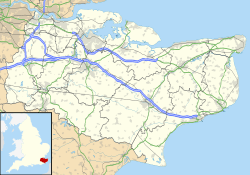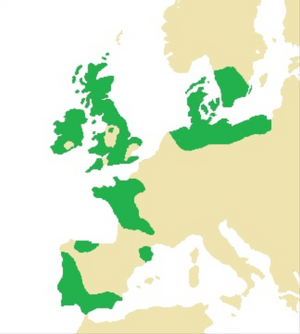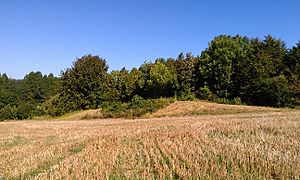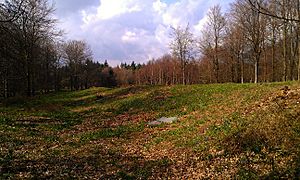Jacket's Field Long Barrow facts for kids
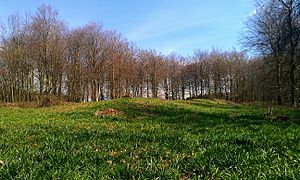
Jacket's Field Long Barrow is located in a woodland clearing
|
|
| Coordinates | 51°12′34″N 0°54′33″E / 51.209500°N 0.909193°E |
|---|---|
| Type | Long barrow |
| History | |
| Founded | Early Neolithic |
| Designated | 1973 |
| Reference no. | 1013071 |
The Jacket's Field Long Barrow is an ancient burial mound located near Boughton Aluph in Kent, England. It was built a very long time ago, around 4,000 to 3,800 BCE, during a period called the Early Neolithic. This was when people in Britain first started farming.
This long barrow is made of earth and looks like a long, slightly uneven mound. It has ditches on its sides. Archaeologists believe it was built by early farming communities who also herded animals. While many similar mounds were built across Europe, Jacket's Field Long Barrow is part of a special group found near the River Stour. It's on the west side of the river, while other famous ones like Julliberrie's Grave are on the east. The site was found in 1970, hidden in thick woods, and hasn't been fully explored by archaeologists yet.
Contents
Where is Jacket's Field Long Barrow?
Jacket's Field Long Barrow is found in a wooded area called Jacket's Field. This is southeast of the village of Boughton Aluph. It sits on a type of soil called Clay-with-Flints within the Soakham Downs. A historic path called the North Downs trackway is about 3 kilometers (2 miles) southwest of the barrow. You can see the barrow from a public path nearby.
Life in the Early Neolithic Period
The Early Neolithic period was a time of big changes in Britain. Between 4500 and 3800 BCE, people living on the British Isles started to farm. They stopped being hunter-gatherers, who found their food by hunting and gathering. This new way of life came from people in mainland Europe. It's not fully clear if new people moved to Britain or if the local people simply learned new farming skills. Kent was an important area for these changes because it was close to Europe and the River Thames.
During this time, Britain was mostly covered in forests. Large areas of forest were not cleared until much later, in the Late Bronze Age. Most archaeologists think that early Neolithic people in Britain mainly herded cattle. They likely moved around a lot, living a nomadic or semi-nomadic life. Even though people across Britain shared some common tools and styles, there were differences in how they lived and built things in different regions.
Ancient Tombs: The Stour Long Barrows
The Early Neolithic period was when humans in Western Europe first started building huge structures in the landscape. Many of these were tombs where people buried their dead. Sometimes these tombs were made of wood, but many used very large stones called "megaliths." People were usually buried together in these tombs, not alone.
Building these large tombs, both wooden and stone, started in Europe and then came to Britain. Many archaeologists believe these tombs were part of an "ancestor cult." This means people respected and honored the spirits of their dead ancestors. These long barrows might have been used for other ceremonies too. Some historians call them "tomb-shrines" because they served more than one purpose.
In Britain, these long barrows were often built on hills or slopes. They might have marked the edges of different groups' lands. Archaeologists think they showed who owned the land or what group lived there. Others suggest they were markers along paths used for herding animals. Building these monuments might have been a way for people to show control over the land as they started farming. Some also think these places were already special to hunter-gatherers before the barrows were built.
Archaeologists know about twelve Neolithic long barrows in Kent. The most well-known are the Medway Megaliths, which are near the River Medway. These include famous sites like Kit's Coty House and the Coldrum Stones. These Medway sites all have stone burial chambers.
About 38 kilometers (24 miles) east of the Medway Megaliths are the Stour long barrows. This group has three known mounds: Jacket's Field Long Barrow, Julliberrie's Grave, and Shrub's Wood Long Barrow. They are all within 8 kilometers (5 miles) of each other, high up on the North Downs. Jacket's Field is on the west side of the River Stour, while the other two are on the east. Unlike the Medway Megaliths, the Stour long barrows do not seem to have used large stones. This was probably a choice, as stones were available nearby if they wanted them.
The presence of these long barrows suggests that there were settlements nearby during the Early Neolithic period. Two polished flint axes from this time have been found near Jacket's Field Long Barrow. The North Downs trackway might have been used then, helping people travel west.
What Does Jacket's Field Long Barrow Look Like?
Jacket's Field Long Barrow has a slightly uneven, "trapezoidal" shape. It is aligned from the east/southeast to the west/southwest. The mound is about 70 meters (230 feet) long. It is wider at its eastern end, about 12 meters (39 feet) wide, and narrower at the western end, about 10 meters (33 feet) wide. At its western end, it is about 1 meter (3 feet) high, and at the eastern end, it is almost 2 meters (6.5 feet) high. There are signs of ditches that once ran along the sides of the mound.
How Was It Discovered?
While Julliberrie's Grave has been known for centuries, Jacket's Field Long Barrow and Shrub's Wood Long Barrow were only found more recently. An archaeologist named Ronald Jessup, who studied Julliberrie's Grave in the 1930s, thought there might be other long barrows in the area.
In 1970, J. Bradshaw reported in a journal called Archaeologia Cantiana that Jacket's Field Long Barrow had been discovered. It was hidden in dense woodland. The Ordnance Survey archaeological team checked it out and confirmed it was indeed an ancient site. Because of its importance, it was then made a Scheduled Ancient Monument. This means it's a protected historical site.
As of 2007, neither Jacket's Field nor Shrub's Wood had been fully dug up and studied by archaeologists.


